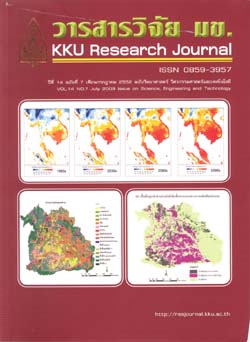Impact of global warming on three major field crops production of Thailand (Thai)
Main Article Content
Abstract
Sugarcane, Cassava and Maize, crops for food feed and fuel, are important economic crops of Thailand. However, variation in yields are often occurred throughout the country because of the variation of soil properties and climate i.e. rainfall, temperature and the amount of CO2 . The objective of this study is to define where (spatial), when (temporal) and magnitude of the impact of global warming on the 3 major field crops production. GIS and a DSSAT model, coupled under the CropDSS 1.0 shell, are employed in this research to simulate yield throughout the country during 1980-2099. Map data of growing areas were obtained from land use map. Weather data set from ECHAM4 A2 GCM and downscaled by PRECIS regional climate model was managed and input into the model including genetic coefficients, soil data, the atmospheric CO2 concentration which increase from 330 ppmv in 1980 to 833 ppmv in 2099, and management of crop production. Preliminary results have shown that simulated cassava and maize yield in 2090-99 will be decreased by 43% and 15% respectively from 1980-89 (base year) but increased by 6% in sugarcane. However, the yields are much fluctuate in both temporal and spatial of the future climate systems by 41% and 45% on maize, 34% and 33% on cassava and 18% and 23% on sugarcane due to change in climate and soil and their interactions between climate and soil properties at the given area throughout the country. The hotspots on the cassava production map during 3 periods have been defined and revealed that there were 91,776 rais (0.70 %) in base year, 4,429,644 rais (35 %) in 2030-39 and 10,064,926 rais (79 %) in 2090-99. These phenomena suggest that cassava yield will be much affected by the climate change. The hotspots for maize, there are 1,091,959 rais in base year, 859,996 rais in 2030-39 and 1,292,906 rais in 2090-99. For sugarcane, the yields are still low in the Northeast region in the base year (15%), however, its area are reduce to 1% and 0.1% in 2030-2039 and 2090-2099, respectively.


